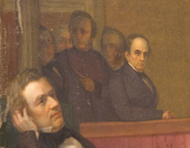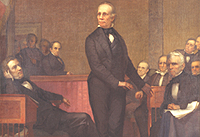DEFEAT
Phineas Staunton lost the competition and its monetary prize by a narrow 4-3 vote of the selection committee. Why did Staunton’s entry lose the competition? Legend has it that the presence of too many Northerners in the painting jeopardized Staunton's chances of winning.
Staunton’s composition surrounds Clay with pro-Union statesmen and celebrates his willingness to compromise with the North in order to avert civil war. Although Kentucky remained loyal to the Union, a strong minority in the state supported the cause of the Confederacy. By mid-1866, when the competition was judged, the political tenor in the state had shifted to a more pro-southern stance.
The reason for Staunton’s defeat, however, may be as simple as his failure to adhere to the terms of the resolution. Kentucky’s governor directed the selection committee to choose the entry that best met the criteria for competition. Unlike a standard portrait, Staunton’s entry showed Clay along with a group of his contemporaries. The legislation called for a single portrait of Henry Clay, and the winning entry by William Frye fulfilled that request.
"The Artist has introduced Mr. Clay as in the Old Senate Chamber, surrounded by his friends, men of national renown, listening to the entrancing words which charmed always those who heard them.”
Franklin County Commonwealth, 1866

Two figures in Staunton's group portrait
represent Northern states: William Seward
(bottom left) and Daniel Webster (far right).

Staunton's painting included thirteen
figures, but the competition called for
a single portrait of Clay.

